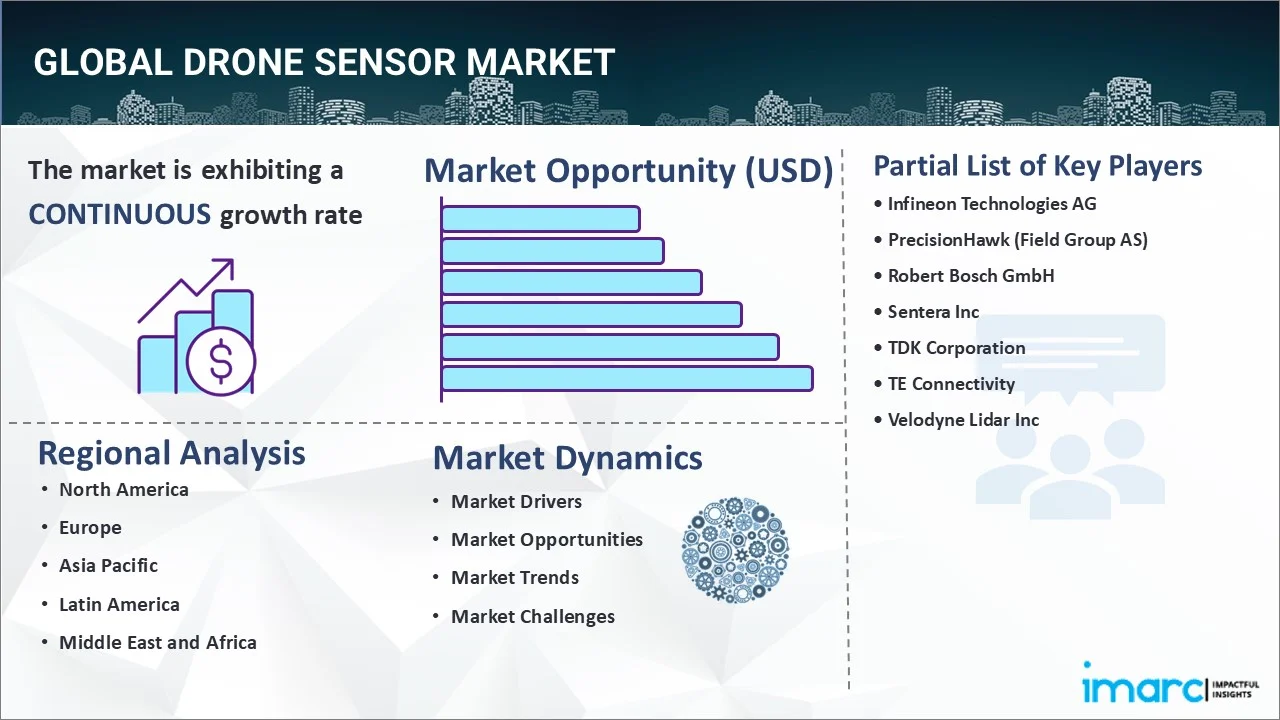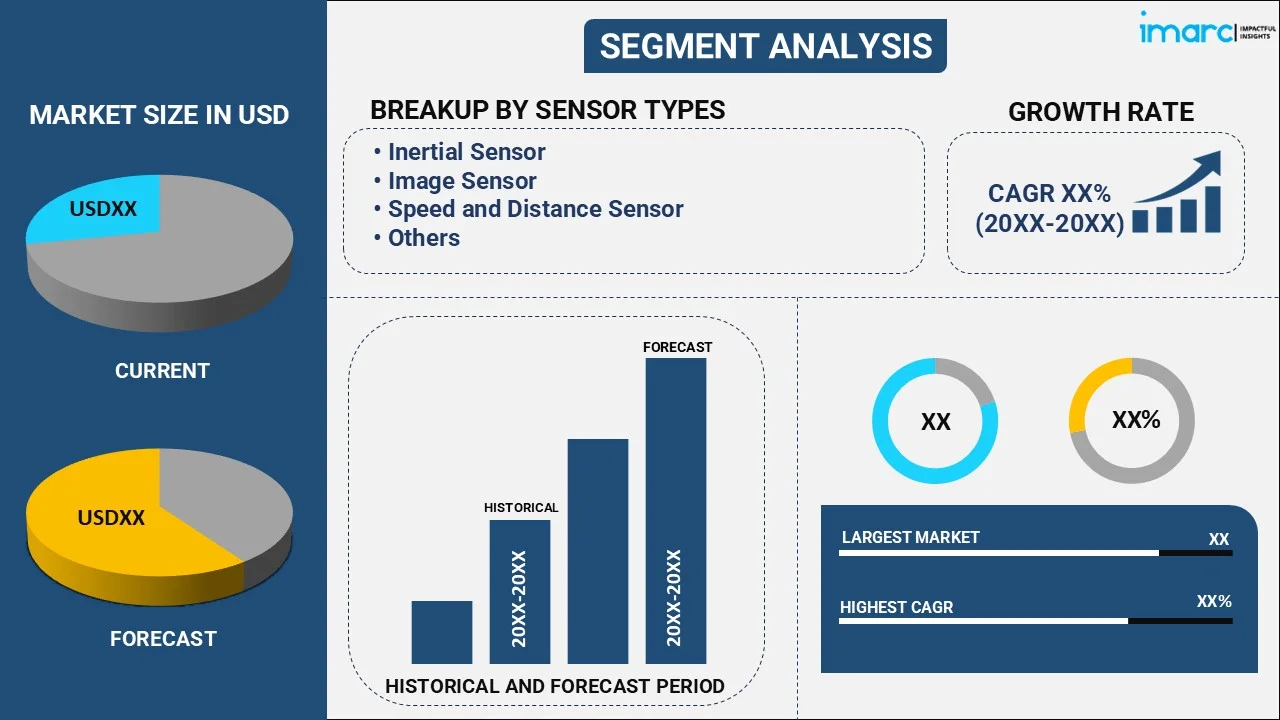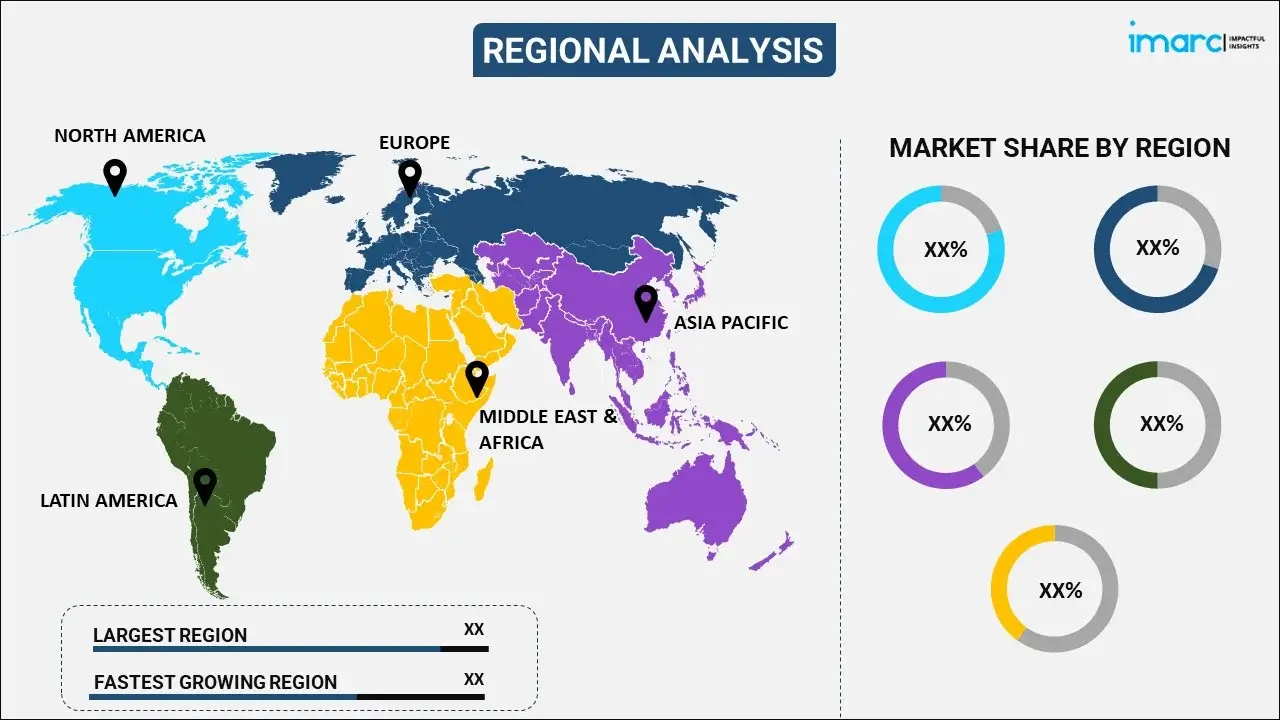
Drone Sensor Market Report by Sensor Type (Inertial Sensor, Image Sensor, Speed and Distance Sensor, Position Sensor, Pressure Sensor, Light Sensor, Current Sensor, and Others), Platform Type (VTOL (Vertical Take-off and Landing), Fixed-Wing, Hybrid), Application (Navigation, Collision Detection and Avoidance, Data Acquisition, Motion Detection, Air Pressure Measurement, and Others), End User (Construction, Media and Entertainment, Precision Agriculture, Personal, Security and Surveillance, Defense, Law Enforcement, Transportation, and Others), and Region 2025-2033
Market Overview:
The global drone sensor market size reached USD 981 Million in 2024. Looking forward, IMARC Group expects the market to reach USD 5,017 Million by 2033, exhibiting a growth rate (CAGR) of 19.9% during 2025-2033. The increasing applications of drones in various sectors, recent advancements in sensor technology, decreasing costs of drones, and escalating use of drones in the commercial sector are some of the major factors propelling the market.
|
Report Attribute
|
Key Statistics |
|---|---|
|
Base Year
|
2024 |
|
Forecast Years
|
2025-2033
|
|
Historical Years
|
2019-2024
|
| Market Size in 2024 | USD 981 Million |
| Market Forecast in 2033 | USD 5,017 Million |
| Market Growth Rate (2025-2033) | 19.9% |
Drone sensors are devices that serve as critical components in the design and functionality of unmanned aerial vehicles (UAVs), enabling them to gather, process, and relay information about their surroundings. They play a significant role in determining a drone's purpose, potential uses, and the types of data it can collect. Some common types of drone sensors include cameras, LiDAR, thermal sensors, multispectral sensors, radar, ultrasonic sensors, GPS, gyroscopes, and accelerometers. These sensors help drones to safely and accurately navigate their surroundings and complete their tasks. As a result, drone sensors are widely used to facilitate the efficient and smooth operation of drones for numerous applications, such as entertainment, professional photography and videography, inspections, agriculture, and surveillance.

To get more information on this market, Request Sample
The increasing applications of drones in various sectors, including agriculture, defense, infrastructure, environmental studies, and emergency services, represents the primary factor supporting market growth. Additionally, recent advancements in sensor technology and decreasing costs of drones are other major growth-inducing factors. Besides this, the rising adoption of drone sensor technology in the agriculture industry for tasks such as crop monitoring, irrigation management, and pest control is contributing to the market expansion. Furthermore, in the defense sector, the growing utilization of drones equipped with advanced sensors for surveillance, reconnaissance, and security operations has catalyzed the demand for drone sensors. Along with this, the escalating use of drones in the commercial sector for infrastructure inspection, mapping, and delivery services is propelling market growth. Moreover, extensive investments in research and development (R&D) activities to enhance sensor capabilities and continual technological advancements are expected to drive the market further.
Drone Sensor Market Trends/Drivers:
Rise in drone applications across diverse sectors
Drones have wide applications in numerous industries, such as agriculture, construction, infrastructure inspection, defense, surveillance, mapping, and delivery services. The versatility of drones has made them a valuable tool in a wide array of sectors. For instance, drones equipped with multispectral sensors are employed in the agriculture industry to monitor crop health, optimize irrigation, and control pests, improving crop yield and efficiency. Besides this, drones provide safer and more efficient methods for inspecting and mapping sites in the construction sector. As a result, the expanding range of applications and the growing demand for drone sensors from these end use sectors are projected to fuel the growth of the market during the forecast period.
Increase in regulatory support
As drones have become more prevalent, many countries across the world have revised their regulations to facilitate their usage, especially in commercial and industrial settings. For instance, the ease of restrictions on flying drones beyond the visual line of sight (BVLOS) has significantly increased their utility in sectors such as delivery services and inspections. Such support from regulatory bodies has encouraged the widespread adoption of drone technology, thereby driving the demand for drone sensors. This, coupled with the declining costs of drones owing to the maturation and scaling of drone technology, is anticipated to propel the expansion of the drone sensor market during the forecast period.
Surge in technological advancements by key players
Rapid advancements in technology have led to the development of more sophisticated, reliable, and diverse sensors. For instance, improvements in thermal imaging technology have increased its utility in fields such as search and rescue, surveillance, and energy auditing. Similarly, advances in LiDAR technology have significantly enhanced the accuracy of 3D mapping. Also, the launch of more compact, efficient, and precise drone sensors is contributing to the development of novel drones with improved functionalities, making them more attractive for diverse uses. Such technological innovations are expanding the capabilities of drones, which in turn is predicted to fuel the growth of the drone sensor market during the forecast period.
Drone Sensor Industry Segmentation:
IMARC Group provides an analysis of the key trends in each segment of the global drone sensor market report, along with forecasts at the global, regional, and country levels from 2025-2033. Our report has categorized the market based on sensor type, platform type, application, and end user.
Breakup by Sensor Type:

- Inertial Sensor
- Image Sensor
- Speed and Distance Sensor
- Position Sensor
- Pressure Sensor
- Light Sensor
- Current Sensor
- Others
Image sensors are the most popular type
The report has provided a detailed breakup and analysis of the market based on the sensor type. This includes inertial sensor, image sensor, speed and distance sensor, position sensor, pressure sensor, light sensor, current sensor, and others. According to the report, image sensor represented the largest segment.
Image sensors are commonly incorporated into drones in the form of cameras and are the most widely used type of drone sensors. Cameras on drones find a wide range of applications, including recreational photography and videography, to commercial uses like real estate photography, land surveying, and infrastructure inspection. The data captured by image sensors, such as photos and videos, are easy to interpret by both professionals and laypersons, making these sensors user-friendly. The main factors driving the growth of this segment include the versatility and ease of use provided by image sensors. Moreover, continuous advancements in camera technology, such as improvements in resolution, the development of 360-degree cameras, and the advent of thermal imaging, have increased the utility and effectiveness of drone cameras, contributing to the expansion of this segment.
Breakup by Platform Type:
- VTOL (Vertical Take-off and Landing)
- Fixed-Wing
- Hybrid
Fixed-Wing are the largest platform type
A detailed breakup and analysis of the market based on the platform type has also been provided in the report. This includes VTOL (vertical take-off and landing), fixed-wing, and hybrid. According to the report, fixed-wing accounted for the largest market share.
Fixed-wing drones comprise a rigid tilted wing designed to look and work like an airplane, providing the lift effect while cruising instead of relying on vertical lift rotors. They can cover more distance on a single charge or tank of fuel because they use the lift from their wings instead of propellers to stay aloft. This makes them ideal for tasks that require prolonged flight, such as large-scale mapping, surveillance, agricultural monitoring, and environmental research. They also have a larger payload capacity compared to multi-rotor drones of the same size, allowing them to carry more or larger sensors, making them suitable for complex data-gathering tasks. As a result, the greater stability, speed, and range offered by fixed-wing drones are driving the growth of this segment.
Breakup by Application:
- Navigation
- Collision Detection and Avoidance
- Data Acquisition
- Motion Detection
- Air Pressure Measurement
- Others
Navigation represents the largest application segment
The report has provided a detailed breakup and analysis of the market based on the application. This includes navigation, collision detection and avoidance, data acquisition, motion detection, air pressure measurement, and others. According to the report, navigation represented the largest segment.
Drone sensors play a vital role in navigation, ensuring that drones can effectively and accurately move from one location to another and perform various tasks while avoiding obstacles. As a result, the growing need for effective and reliable navigation systems in drone operations has generated the demand for drone sensors, such as GPS for location tracking, accelerometers and gyroscopes for motion and orientation, and altimeters for altitude measurement. Furthermore, navigational sensors are useful in ensuring the safety of drone operations by preventing collisions and helping drones to respond to unexpected situations. Besides this, the escalating demand for fully autonomous drone operations capable of real-time decision-making in complex and often changing environments is accelerating the adoption of various high-performance sensors, thereby propelling the segment growth.
Breakup by End User:
- Construction
- Media and Entertainment
- Precision Agriculture
- Personal
- Security and Surveillance
- Defense
- Law Enforcement
- Transportation
- Others
Defense represents the largest end user segment
A detailed breakup and analysis of the market based on the end user has also been provided in the report. This includes construction, media and entertainment, precision agriculture, personal, security and surveillance, defense, law enforcement, transportation, and others. According to the report, defense accounted for the largest market share.
Drones equipped with advanced sensors have become essential tools in the defense sector for surveillance and reconnaissance missions. These sensors, including high-resolution cameras, thermal imaging sensors, and Lidar, can capture detailed images and videos from significant distances, allowing effective monitoring of potential threats. The main factor driving the growth of this segment is the rising use of drones as a safer alternative for risk mitigation missions that might otherwise put military personnel at risk due to their operational efficiency. In addition to this, the expanding defense budgets of various nations across the globe and the increasing regulatory constraints are other major factors augmenting the growth of this segment.
Breakup by Region:

- North America
- United States
- Canada
- Europe
- Germany
- France
- United Kingdom
- Italy
- Spain
- Others
- Asia Pacific
- China
- Japan
- India
- South Korea
- Australia
- Indonesia
- Others
- Latin America
- Brazil
- Mexico
- Others
- Middle East and Africa
North America exhibits a clear dominance, accounting for the largest drone sensors market share
The report has also provided a comprehensive analysis of all the major regional markets, which include North America (the United States and Canada); Europe (Germany, France, the United Kingdom, Italy, Spain, and others); Asia Pacific (China, Japan, India, South Korea, Australia, Indonesia, and others); Latin America (Brazil, Mexico, and others); and the Middle East and Africa. According to the report, North America was the largest market for drone sensors.
North America held the biggest market share since the region has a robust defense infrastructure and comprises developed nations such as the United States. The United States has been driving market growth owing to the presence of numerous leading tech companies and research institutions that are continually advancing sensor technology. These developments enhance the capabilities of drones, making them more appealing and versatile across various sectors.
Another contributing aspect is the increasing commercial applications of drones, such as precision agriculture, infrastructure inspection, real estate photography, and delivery services. The growing demand in these areas is strengthening the need for various types of sensors, such as image, thermal, Lidar, and multispectral sensors. In line with this, the regulatory progress toward drone usage and the increase in research-related efforts from private companies and public entities are driving the growth of the market in the North America region.
Competitive Landscape:
The market is experiencing steady growth owing to the presence of several key players, both established companies and startups, striving to develop technologically advanced sensors to gain a competitive edge. These players are focusing on developing smart sensors integrated with novel technologies like artificial intelligence (AI) that can detect multiple parameters, such as temperature, rain, humidity, and rain. The market is witnessing a steady rise in research and development (R&D) initiatives as well as investments, leading to frequent introductions of new and advanced products, which has further increased competition. We expect the market to witness new entrants, consolidation of portfolios, and a rise in strategic collaborations to drive healthy competition within the domain.
The report has provided a comprehensive analysis of the competitive landscape in the market. Detailed profiles of all major companies have also been provided. Some of the key players in the market include:
- Infineon Technologies AG
- PrecisionHawk (Field Group AS)
- Robert Bosch GmbH
- Sentera Inc
- TDK Corporation
- TE Connectivity
- Velodyne Lidar Inc
Recent Developments:
- In January 2018, Bosch Sensortec GmbH, a fully owned subsidiary of Robert Bosch GmbH, launched the MEMS sensor BMI088 at the 2018 Consumer Electronics Show (CES) in Las Vegas, USA. It is a high-performance Inertial Measurement Unit (IMU) with outstanding vibration robustness, specifically designed for drone and robotics applications. The BMI088 features an extremely stable gyroscope obtained from Bosch’s proven automotive technology and delivers low noise and drift despite fluctuating temperatures.
- In May 2020, TDK Corporation announced the launch of InvenSense ICM-42688-P high-performance motion sensor, a 6-axis MEMS MotionTracking device that integrates a 3-axis gyroscope and a 3-axis accelerometer in a 2.5mm x 3mm x 0.9mm package. This device enables high-precision motion sensing applications, such as robotics, wearable devices, drones, and other IoT devices.
- In August 2019, Velodyne Lidar, Inc. introduced the Puck 32MR sensor to address key markets in the autonomous segment. This breakthrough sensor offers a cost-effective perception solution for low-speed autonomous systems, including industrial vehicles, robotics, shuttles, and unmanned aerial vehicles (UAVs). The Puck 32MR has strengthened the company's robust portfolio of patented sensor technology, delivering rich perception data for mid-range applications.
Drone Sensor Market Report Scope:
| Report Features | Details |
|---|---|
| Base Year of the Analysis | 2024 |
| Historical Period | 2019-2024 |
| Forecast Period | 2025-2033 |
| Units | Million USD |
| Scope of the Report | Exploration of Historical and Forecast Trends, Industry Catalysts and Challenges, Segment-Wise Historical and Predictive Market Assessment:
|
| Sensor Types Covered | Inertial Sensor, Image Sensor, Speed and Distance Sensor, Position Sensor, Pressure Sensor, Light Sensor, Current Sensor, Others |
| Platform Types Covered | VTOL (Vertical Take-off and Landing), Fixed-Wing, Hybrid |
| Applications Covered | Navigation, Collision Detection and Avoidance, Data Acquisition, Motion Detection, Air Pressure Measurement, Others |
| End Users Covered | Construction, Media and Entertainment, Precision Agriculture, Personal, Security and Surveillance, Defense, Law Enforcement, Transportation, Others |
| Regions Covered | Asia Pacific, Europe, North America, Latin America, Middle East and Africa |
| Countries Covered | United States, Canada, Germany, France, United Kingdom, Italy, Spain, China, Japan, India, South Korea, Australia, Indonesia, Brazil, Mexico |
| Companies Covered | Infineon Technologies AG, PrecisionHawk (Field Group AS), Robert Bosch GmbH, Sentera Inc, TDK Corporation, TE Connectivity, Velodyne Lidar Inc, etc. |
| Customization Scope | 10% Free Customization |
| Post-Sale Analyst Support | 10-12 Weeks |
| Delivery Format | PDF and Excel through Email (We can also provide the editable version of the report in PPT/Word format on special request) |
Key Questions Answered in This Report:
- How has the global drone sensor market performed so far, and how will it perform in the coming years?
- What are the drivers, restraints, and opportunities in the global drone sensor market?
- What is the impact of each driver, restraint, and opportunity on the global drone sensor market?
- What are the key regional markets?
- Which countries represent the most attractive drone sensor market?
- What is the breakup of the market based on the sensor type?
- Which is the most attractive sensor type in the drone sensor market?
- What is the breakup of the market based on the platform type?
- Which is the most attractive platform type in the drone sensor market?
- What is the breakup of the market based on the application?
- Which is the most attractive application in the drone sensor market?
- What is the breakup of the market based on the end user?
- Which is the most attractive end user in the drone sensor market?
- What is the competitive structure of the global drone sensor market?
- Who are the key players/companies in the global drone sensor market?
Key Benefits for Stakeholders:
- IMARC’s report offers a comprehensive quantitative analysis of various market segments, historical and current market trends, market forecasts, and dynamics of the drone sensor market from 2019-2033.
- The research study provides the latest information on the market drivers, challenges, and opportunities in the global drone sensor market.
- The study maps the leading, as well as the fastest-growing, regional markets. It further enables stakeholders to identify the key country-level markets within each region.
- Porter's five forces analysis assist stakeholders in assessing the impact of new entrants, competitive rivalry, supplier power, buyer power, and the threat of substitution. It helps stakeholders to analyze the level of competition within the drone sensor industry and its attractiveness.
- Competitive landscape allows stakeholders to understand their competitive environment and provides an insight into the current positions of key players in the market.
Need more help?
- Speak to our experienced analysts for insights on the current market scenarios.
- Include additional segments and countries to customize the report as per your requirement.
- Gain an unparalleled competitive advantage in your domain by understanding how to utilize the report and positively impacting your operations and revenue.
- For further assistance, please connect with our analysts.
 Request Customization
Request Customization
 Speak to an Analyst
Speak to an Analyst
 Request Brochure
Request Brochure
 Inquire Before Buying
Inquire Before Buying




.webp)




.webp)












